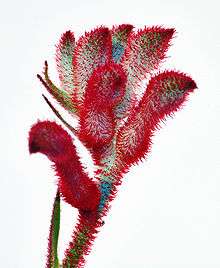Kangaroo paw

Kangaroo paw is the common name for a number of species, in two genera of the family Haemodoraceae, that are endemic to the south-west of Western Australia. These perennial plants are noted for their unique bird attracting flowers. The tubular flowers are coated with dense hairs and open at the apex with six claw-like structures: from this paw formation the common name "kangaroo paw" is derived.[1]
The plant was named after the shape of the flowers, which resemble to the paws of a kangaroo. The kangaroo plant has been introduced into Japan and has been grown as a new ornamental crop mainly in Okinawa Island under a subtropical climate.[2]
Cultural aspect
The plant is native to south-western Australia and has been developed as a cut-flower crop in the United States, Israel and Japan. In Israel, the plants are propagated from tissue culture imported from Australia and are then grown in unheated greenhouses in natural day conditions.[3]
History
In 1990 there was disease found on the kangaroo paw plant in Okinawa. The unreported fungi, which associated the plant becoming very limp and wilt, was characterised by a discolouration of the plant leaving it a brown to black colour around the stalks, leaves and base of the plant. As the plant began to discolour overtime, white cottony mycelia started to appeared at the surface of the lesions and then the plant eventually died.[2]
From the genus Anigozanthos:
- Anigozanthos bicolor Endl. (little kangaroo paw)
- Anigozanthos bicolor ssp. bicolor (two-coloured kangaroo paw)
- Anigozanthos bicolor ssp. decrescens
- Anigozanthos bicolor ssp. exstans
- Anigozanthos bicolor ssp. minor
- Anigozanthos flavidus DC. (tall kangaroo paw)
- Anigozanthos gabrielae Domin (dwarf kangaroo paw)
- Anigozanthos manglesii D.Don (red-and-green kangaroo paw)
- Anigozanthos manglesii ssp. manglesii
- Anigozanthos manglesii ssp. quadrans
- Anigozanthos pulcherrimus Hook. (golden kangaroo paw)
- Anigozanthos rufus Labill. (red kangaroo paw)
- Anigozanthos viridis Endl. (green kangaroo paw)
- Anigozanthos viridis subsp. terraspectans Hopper (dwarf green kangaroo paw)
- Anigozanthos viridis subsp. metallica (metallic green kangaroo paw)
From the genus Macropidia:
- Macropidia fuliginosa (Hook.) Druce (black kangaroo paw)
See also
Additional species in the genus Anigozanthos exist. They resemble kangaroo paws, however, they are instead known as "cat's paws":
- Anigozanthos humilis (cat's paw)
- Anigozanthos humilis ssp. chrysanthus (Mogumber cat's paw)
- Anigozanthos humilis ssp. grandis (tall cat's paw)
- Anigozanthos kalbarriensis (Kalbarri cat's paw)
- Anigozanthos onycis (branched cat's paw)
- Anigozanthos preissii (Albany cat's paw)
References
- ↑ http://www.mullamulladesigns.com/#!kangaroo-paw/zoom/c14ai/imagep1z. Missing or empty
|title=(help) - 1 2 Satou, Ichinoe, Fukumoto, Tezuka, & Horiuchi. (2001). Fusarium blight of kangaroo paw (anigozanthos spp.) caused by fusarium chlamydosporum and fusarium semitectum.Journal of Phytopathology, 149(3‐4), 203-206. doi:10.1046/j.1439-0434.2001.00588.x
- ↑ Tsror (Lahkim), L., Hazanovsky, M., Mordechai‐Lebiush, S., Ben‐David, T., Dori, I., & Matan, E. (2005). Control of root rot and wilt caused by pythium myriotylum in kangaroo paw (anigozanthos). Journal of Phytopathology, 153(3), 150-154. doi:10.1111/j.1439-0434.2005.00944.x
